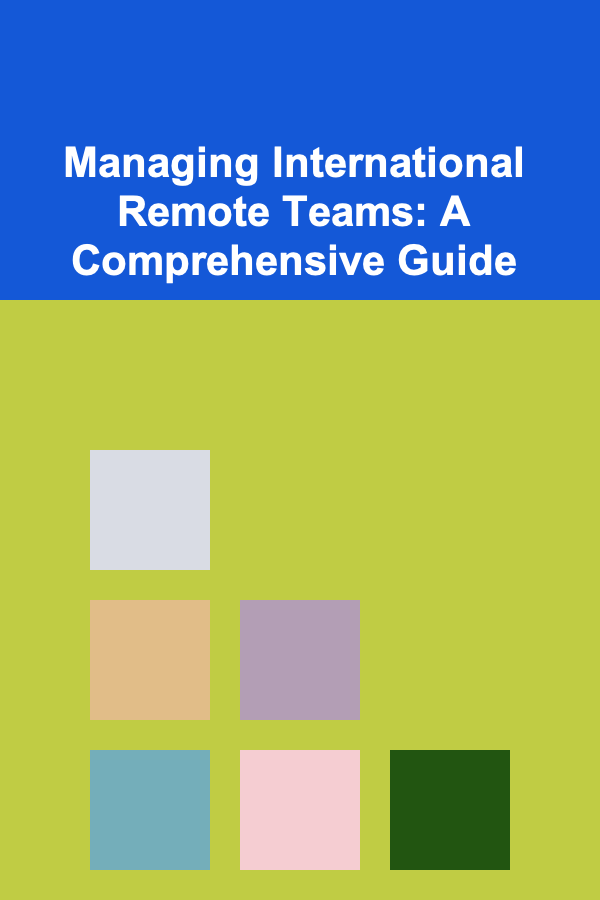
Managing International Remote Teams: A Comprehensive Guide
ebook include PDF & Audio bundle (Micro Guide)
$12.99$11.99
Limited Time Offer! Order within the next:

In an increasingly interconnected world, the rise of remote work has transcended geographical boundaries, leading to the formation of international remote teams. These teams, composed of individuals from diverse cultural backgrounds, time zones, and professional experiences, offer immense potential for innovation, productivity, and global market reach. However, managing such teams effectively presents unique challenges that require a strategic and nuanced approach. This guide delves into the key aspects of managing international remote teams, providing actionable insights and best practices to foster collaboration, communication, and success.
I. Understanding the Landscape: The Challenges and Opportunities
Before diving into specific strategies, it's crucial to acknowledge the unique landscape of managing international remote teams. While the benefits are numerous, several challenges need to be addressed proactively.
A. Challenges:
- Communication Barriers: Language differences, varying communication styles (direct vs. indirect), and cultural nuances can lead to misunderstandings and misinterpretations. This includes not just spoken language, but also nonverbal cues that are easily lost in remote communication.
- Time Zone Differences: Coordinating schedules and ensuring adequate overlap for collaboration can be a logistical nightmare. Time zone disparities can also lead to asynchronous communication, slowing down decision-making processes.
- Cultural Differences: Values, beliefs, and work ethics vary significantly across cultures. Understanding these differences is vital to avoid cultural faux pas, build rapport, and foster inclusivity. This includes understanding hierarchies, attitudes towards deadlines, and preferred methods of conflict resolution.
- Technology and Infrastructure: Unequal access to reliable internet connectivity, adequate hardware, and relevant software can create disparities in team members' ability to contribute effectively.
- Building Trust and Cohesion: Remote environments can make it challenging to build trust and foster a sense of camaraderie among team members. Lack of face-to-face interaction can hinder the development of strong relationships.
- Legal and Regulatory Compliance: Managing employees across different countries involves navigating complex legal and regulatory frameworks related to employment laws, data privacy, and intellectual property.
- Performance Management: Accurately assessing performance and providing constructive feedback in a remote and culturally diverse setting requires careful consideration of individual circumstances and cultural norms.
- Motivation and Engagement: Maintaining motivation and engagement among remote team members requires proactive effort to combat feelings of isolation and disconnection.
B. Opportunities:
- Access to a Global Talent Pool: Recruit the best talent regardless of location, accessing specialized skills and diverse perspectives that may not be available locally.
- Increased Innovation and Creativity: Diverse perspectives and experiences can lead to more innovative solutions and creative problem-solving.
- Improved Productivity: Remote work can lead to increased productivity due to reduced commute times, fewer distractions, and greater autonomy.
- Enhanced Flexibility and Agility: Remote teams can adapt more quickly to changing market conditions and business needs.
- Cost Savings: Reduced overhead costs associated with office space and infrastructure can lead to significant cost savings.
- Expanded Market Reach: Team members with local market knowledge can help companies expand their reach into new geographic areas.
- 24/7 Coverage: With team members spread across different time zones, companies can provide round-the-clock customer support and services.
II. Building a Strong Foundation: Essential Strategies
Effectively managing international remote teams requires a proactive and strategic approach. Here are some essential strategies to build a strong foundation for success:
A. Establish Clear Communication Protocols:
- Define Communication Channels: Clearly outline which communication channels should be used for different types of communication (e.g., email for formal announcements, instant messaging for quick questions, video conferencing for meetings).
- Set Response Time Expectations: Establish clear expectations for response times to emails and messages, taking into account time zone differences.
- Encourage Active Listening: Promote active listening skills and emphasize the importance of clarifying any misunderstandings.
- Use Visual Aids: Incorporate visual aids such as diagrams, charts, and screen sharing to enhance communication and comprehension.
- Document Everything: Document important decisions, discussions, and action items in a central repository for easy access and reference.
- Consider Language Support: Provide language training or translation services to support team members who may not be fluent in the primary language. This could involve offering subsidized language courses or utilizing translation tools during meetings.
B. Embrace Asynchronous Communication:
- Utilize Collaboration Tools: Leverage project management software, shared documents, and other collaboration tools to facilitate asynchronous communication and collaboration.
- Record Meetings: Record meetings and make them available for team members who are unable to attend due to time zone differences.
- Document Processes and Procedures: Clearly document processes and procedures to reduce the need for constant back-and-forth communication.
- Create a Knowledge Base: Develop a centralized knowledge base with frequently asked questions, training materials, and other relevant information.
- Encourage Proactive Communication: Encourage team members to proactively share updates and information, even if not explicitly requested. This minimizes the reliance on real-time interaction and keeps everyone informed.
C. Foster a Culture of Trust and Transparency:
- Lead by Example: Demonstrate trust and transparency in your own actions and communications.
- Share Information Openly: Share information openly and honestly with team members, even when it's difficult or challenging.
- Encourage Feedback: Create a safe space for team members to provide feedback and voice their concerns.
- Recognize and Reward Contributions: Publicly recognize and reward team members' contributions to foster a sense of appreciation and value.
- Build Personal Connections: Facilitate opportunities for team members to connect on a personal level, such as virtual coffee breaks or team-building activities.
- Establish Clear Expectations and Accountability: Clearly define roles, responsibilities, and performance expectations. Implement mechanisms for tracking progress and holding individuals accountable for their contributions.
D. Navigate Cultural Differences:
- Provide Cultural Sensitivity Training: Offer cultural sensitivity training to help team members understand and appreciate different cultural perspectives.
- Encourage Cultural Exchange: Facilitate opportunities for team members to share their cultural experiences and traditions.
- Be Mindful of Communication Styles: Be aware of different communication styles (e.g., direct vs. indirect, formal vs. informal) and adapt your communication accordingly.
- Avoid Making Assumptions: Avoid making assumptions based on cultural stereotypes.
- Promote Inclusivity: Create a welcoming and inclusive environment where everyone feels valued and respected. This means being aware of cultural holidays and customs and avoiding language or humor that may be offensive.
- Understand Hofstede's Cultural Dimensions: Familiarize yourself with Hofstede's Cultural Dimensions (Power Distance, Individualism vs. Collectivism, Masculinity vs. Femininity, Uncertainty Avoidance, Long-Term Orientation vs. Short-Term Normative Orientation, Indulgence vs. Restraint) to gain a deeper understanding of cultural values and their impact on workplace dynamics.
E. Utilize Technology Effectively:
- Provide Access to Reliable Technology: Ensure that all team members have access to reliable internet connectivity, adequate hardware, and relevant software. Consider providing stipends for internet access or equipment upgrades.
- Choose the Right Tools: Select communication and collaboration tools that are appropriate for the team's needs and preferences. Consider factors such as ease of use, features, and cost.
- Provide Training on Technology: Offer training on how to use the chosen technology effectively.
- Establish Technology Support: Provide ongoing technology support to help team members troubleshoot issues and resolve technical problems.
- Regularly Evaluate Technology: Regularly evaluate the effectiveness of the technology being used and make adjustments as needed.
- Ensure Data Security: Implement robust security measures to protect sensitive data and ensure compliance with data privacy regulations. This includes using strong passwords, enabling two-factor authentication, and encrypting sensitive data.
F. Establish Clear Goals and Objectives:
- Define SMART Goals: Set Specific, Measurable, Achievable, Relevant, and Time-bound goals for the team and individual team members.
- Communicate Goals Clearly: Communicate goals clearly and ensure that everyone understands their role in achieving them.
- Track Progress Regularly: Track progress regularly and provide feedback to team members.
- Celebrate Successes: Celebrate successes to motivate team members and reinforce positive behaviors.
- Align Goals with Company Strategy: Ensure that team goals are aligned with the overall company strategy.
- Use Key Performance Indicators (KPIs): Define and track KPIs to measure performance and identify areas for improvement.
III. Maintaining Momentum: Ongoing Management and Best Practices
Building a strong foundation is only the first step. Ongoing management and adherence to best practices are essential for maintaining momentum and ensuring long-term success.
A. Regular Check-ins and Feedback:
- Schedule Regular Meetings: Schedule regular team meetings and one-on-one meetings to provide opportunities for communication, feedback, and support. The frequency of these meetings should be tailored to the team's needs and the complexity of their projects.
- Provide Constructive Feedback: Provide constructive feedback regularly, focusing on both strengths and areas for improvement.
- Encourage Peer Feedback: Encourage team members to provide feedback to each other.
- Utilize 360-Degree Feedback: Consider using 360-degree feedback to gather input from multiple sources, including peers, supervisors, and subordinates.
- Implement Performance Reviews: Conduct regular performance reviews to assess progress against goals and identify development opportunities.
- Use Feedback Tools: Leverage online feedback tools and platforms to streamline the feedback process and track progress.
B. Conflict Resolution:
- Establish a Conflict Resolution Process: Establish a clear and transparent conflict resolution process that all team members understand.
- Encourage Open Communication: Encourage team members to communicate openly and honestly about their concerns.
- Mediate Conflicts: Mediate conflicts impartially and facilitate productive dialogue between conflicting parties.
- Focus on Solutions: Focus on finding solutions that are mutually beneficial to all parties involved.
- Document Conflict Resolution Efforts: Document all conflict resolution efforts and outcomes.
- Provide Training on Conflict Resolution: Offer training on conflict resolution techniques to equip team members with the skills to manage disagreements effectively.
C. Team Building Activities:
- Virtual Team Building Games: Organize virtual team building games and activities to foster camaraderie and build relationships. Examples include online trivia, virtual escape rooms, and online Pictionary.
- Virtual Coffee Breaks: Schedule regular virtual coffee breaks to provide opportunities for informal conversation and social interaction.
- Online Social Events: Organize online social events such as virtual happy hours or movie nights.
- Share Personal Interests: Encourage team members to share their personal interests and hobbies.
- Celebrate Birthdays and Milestones: Celebrate birthdays and milestones to show appreciation and build a sense of community.
- Use Icebreaker Questions: Start meetings with icebreaker questions to encourage participation and foster a more relaxed atmosphere.
D. Empowerment and Autonomy:
- Delegate Responsibilities: Delegate responsibilities to team members and empower them to make decisions.
- Provide Autonomy: Provide team members with autonomy over their work and schedules.
- Trust Team Members: Trust team members to do their jobs effectively.
- Encourage Innovation: Encourage team members to innovate and experiment with new ideas.
- Provide Support and Resources: Provide team members with the support and resources they need to succeed.
- Offer Opportunities for Professional Development: Provide opportunities for team members to develop their skills and advance their careers. This could include online courses, conferences, or mentorship programs.
E. Performance Management in a Remote Setting:
- Focus on Outcomes: Focus on outcomes rather than hours worked.
- Use Objective Metrics: Use objective metrics to measure performance.
- Regularly Track Progress: Regularly track progress and provide feedback.
- Provide Clear Expectations: Provide clear expectations and hold team members accountable for their performance.
- Recognize and Reward High Performers: Recognize and reward high performers.
- Address Underperformance Promptly: Address underperformance promptly and provide support for improvement.
- Tailor Performance Management to Cultural Norms: Be mindful of cultural differences in performance management and tailor your approach accordingly. Some cultures may prefer indirect feedback, while others may value directness.
F. Continuous Improvement:
- Regularly Evaluate Processes: Regularly evaluate processes and identify areas for improvement.
- Solicit Feedback from Team Members: Solicit feedback from team members on how to improve processes.
- Implement Changes Based on Feedback: Implement changes based on feedback and track the results.
- Stay Up-to-Date on Best Practices: Stay up-to-date on best practices for managing remote teams.
- Embrace a Growth Mindset: Embrace a growth mindset and encourage team members to continuously learn and improve.
- Conduct Retrospectives: Conduct regular retrospectives after projects or significant milestones to identify what went well, what could have been improved, and what lessons were learned.
IV. Legal and Ethical Considerations
Managing international remote teams necessitates a thorough understanding of the legal and ethical considerations involved. These considerations vary significantly across countries and require careful attention to ensure compliance and ethical conduct.
A. Employment Laws:
- Understand Local Employment Laws: Familiarize yourself with the employment laws in each country where your team members are located. This includes laws related to wages, working hours, vacation time, sick leave, and termination.
- Use Employment Contracts: Use clear and comprehensive employment contracts that comply with local laws.
- Ensure Compliance with Tax Laws: Ensure compliance with tax laws in each country where your team members are located. This may involve withholding taxes and making contributions to social security and other government programs.
- Consult with Legal Counsel: Consult with legal counsel to ensure compliance with all applicable employment laws.
B. Data Privacy:
- Comply with Data Privacy Regulations: Comply with data privacy regulations such as the General Data Protection Regulation (GDPR) in Europe and the California Consumer Privacy Act (CCPA) in the United States.
- Obtain Consent for Data Collection: Obtain consent from team members before collecting and processing their personal data.
- Protect Personal Data: Protect personal data from unauthorized access, use, or disclosure.
- Provide Transparency: Provide transparency about how personal data is collected, used, and shared.
C. Intellectual Property:
- Protect Intellectual Property Rights: Protect intellectual property rights by using confidentiality agreements and non-compete agreements.
- Ensure Ownership of Intellectual Property: Ensure that the company owns the intellectual property created by team members.
- Implement Security Measures: Implement security measures to protect intellectual property from theft or infringement.
D. Ethical Conduct:
- Promote Ethical Behavior: Promote ethical behavior by setting clear ethical standards and providing training on ethical conduct.
- Address Ethical Concerns Promptly: Address ethical concerns promptly and investigate any allegations of unethical behavior.
- Create a Culture of Integrity: Create a culture of integrity where ethical behavior is valued and rewarded.
- Be Aware of Cultural Norms: Be aware of cultural norms related to ethical conduct and adapt your approach accordingly.
E. Cybersecurity:
- Implement Strong Cybersecurity Measures: Implement strong cybersecurity measures to protect company data and systems from cyber threats.
- Provide Cybersecurity Training: Provide cybersecurity training to team members to help them identify and avoid cyberattacks.
- Use Secure Communication Channels: Use secure communication channels to protect sensitive information.
- Regularly Update Software: Regularly update software to patch security vulnerabilities.
- Implement Multi-Factor Authentication: Implement multi-factor authentication to protect accounts from unauthorized access.
V. Conclusion: Embracing the Future of Work
Managing international remote teams is a complex but rewarding endeavor. By understanding the challenges and opportunities, building a strong foundation, maintaining momentum, and adhering to legal and ethical considerations, organizations can unlock the immense potential of these teams and achieve significant business outcomes. As the world becomes increasingly interconnected, the ability to effectively manage international remote teams will be a critical competitive advantage. Embracing the future of work requires a commitment to continuous learning, adaptation, and a focus on building a truly global and inclusive workforce.

How to Create Memorable Holiday Traditions with Decorations
Read More
How to Implement Account-Based Sales Strategies for B2B Success
Read More
How to Monitor and Measure Sales Performance for Continuous Improvement
Read More
How to Select Energy-Efficient Bulbs for Your Home
Read More
How to Stage Your Bathroom to Maximize Space and Appeal
Read More
How To Acquire Another Business
Read MoreOther Products

How to Create Memorable Holiday Traditions with Decorations
Read More
How to Implement Account-Based Sales Strategies for B2B Success
Read More
How to Monitor and Measure Sales Performance for Continuous Improvement
Read More
How to Select Energy-Efficient Bulbs for Your Home
Read More
How to Stage Your Bathroom to Maximize Space and Appeal
Read More